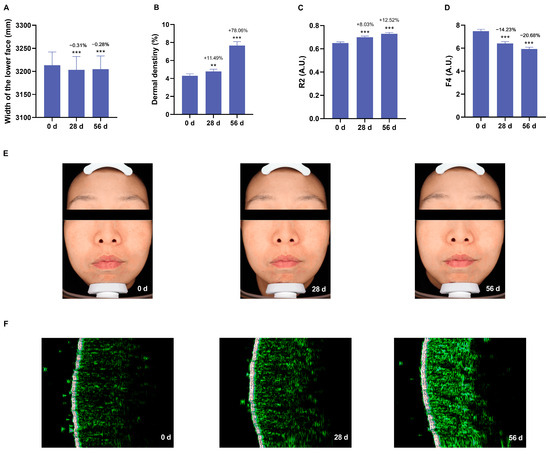Skin aging is driven by both intrinsic chronologic processes and extrinsic factors, primarily photoaging due to ultraviolet (UV) exposure. This degradation manifests as wrinkles, sagging, laxity, and uneven texture, underpinned by structural changes in the extracellular matrix (ECM). Critical components like collagen fibers and elastin networks become fragmented and depleted. Furthermore, a decline in the expression and activity of lysyl oxidase (LOX), an enzyme essential for catalyzing the covalent cross-linking of collagen and elastin fibers, contributes significantly to weaker, more fragile collagen bundles and reduced skin elasticity. Consequently, restoring collagen, elastin, and LOX levels is a vital strategy for effective anti-aging interventions.
A conventional approach uses peptides, which are widely utilized in cosmetic formulations to stimulate ECM synthesis and dermal matrix renewal. However, peptides often exhibit limited effects against photoaging-related oxidative stress and lack intrinsic free-radical scavenging activity. To complement these limitations, the study explored silybin, a major flavonolignan from Silybum marianum, which has demonstrated notable antioxidant, anti-inflammatory, and photoprotective properties. Silybin has been reported to induce morphological changes similar to retinoic acid, promoting basement membrane protein expression and exhibiting anti-aging efficacy superior to, or comparable with, bakuchiol and retinol, respectively, but without causing irritation or photosensitivity. Building on this context, the researchers developed a comprehensive anti-aging formula that merges a multi-mechanistic blend of seven bioactive peptides with silybin’s protective and collagen-boosting properties, anticipating a synergistic effect superior to peptides alone.
Methods
The study employed a translational approach involving four key investigations, starting with in vitro assays using human dermal fibroblasts (HSFs) and normal human epidermal keratinocytes (NHEKs) to measure rapid gene and protein activation of ECM components like collagen I, III, IV, XVII, and LOX. Ex vivo, UV-damaged human skin explants were treated to assess the restoration of collagen, elastic fibers, and LOX using immunofluorescence (IF) and Victoria blue staining. Finally, a 56-day clinical trial (n = 31 female volunteers) was conducted using the final cream formulation, utilizing non-invasive instruments like Primos CR, DUB® SkinScanner, and Cutometer dual MPA580 to measure clinical improvements in wrinkles, dermal density, elasticity (R2), and firmness (F4).
Key Findings
• Rapid Molecular Activation: The cream containing multi-peptides and silybin induced rapid transcriptional activation and protein upregulation of multiple ECM markers, including collagen I, collagen IV, and LOX, observed as early as 4 hours in cultured skin cells.
• Synergistic Restoration Ex Vivo: In UV-damaged human skin explants, treatment with the multi-peptides and silybin complex significantly restored ECM protein levels compared to untreated controls. The co-treatment demonstrated a synergistic benefit compared to multi-peptides alone, particularly enhancing the recovery of collagen types I, III, IV, XVII, and elastic fibers.
• Significant LOX Upregulation: The multi-peptides–silybin complex was found to significantly upregulate LOX expression in both human fibroblasts and UV-aged skin tissue.
• Clinical Efficacy (56 Days): The 56-day clinical evaluation demonstrated significant improvements (all $p < 0.001$) across multiple parameters:
◦ Dermal Density: Increased by 78.06%.
◦ Elasticity (R2): Increased by 12.52%.
◦ Firmness (F4): Decreased by 20.68% (lower F4 indicates greater firmness).
◦ Wrinkle Reduction: Significant reductions were measured in the length, area, and volume of wrinkles across the forehead, nasolabial, glabellar, and cheek regions, with improvements visible by 28 days.
• Tolerability and Satisfaction: The formulation was safe, with a dermatologist assessment confirming minimal irritation and no reported adverse reactions. Consumer satisfaction by day 56 exceeded 80% for items such as improved skin firmness, midface lifting, and jawline definition.
The research successfully validates the hypothesis that combining a unique blend of seven complementary peptides with silybin provides an innovative and clinically effective anti-aging strategy. The novelty of this research lies primarily in providing the first evidence that a cosmetic peptide formulation can significantly upregulate Lysyl Oxidase (LOX) expression in skin cells and tissue explants. This is a critical finding, as enhancing LOX promotes long-term structural integrity and resilience of the dermis by facilitating the covalent cross-linking of collagen and elastin fibers. Furthermore, the study introduced the concept of a “flash-collagen charging” effect by demonstrating the rapid induction of procollagen markers within 4 hours of treatment.
By simultaneously targeting LOX, multiple collagen types (I, III, IV, XVII), and elastin—rebuilding the dermal matrix, strengthening the Dermal–Epidermal Junction (DEJ), and improving fiber resilience—the complex addresses the structural causes of skin aging on multiple levels. The future implication of these findings is that they introduce a compelling new paradigm for next-generation anti-aging cosmeceuticals, emphasizing a synergistic, multi-mechanism approach that targets both the quantity and quality of the dermal ECM. Future studies should aim to further elucidate the precise mechanisms underlying these synergistic effects and investigate whether other botanicals might confer complementary benefits when combined with peptide blends.
Link to the study: https://www.mdpi.com/2079-9284/12/5/223

In the figure: Improvement in facial firmness after 28 and 56 days of clinical cream application. (A,E) Lower face width (mm) assessed by Visia 7 (cross-polarized light) showing facial contour changes over time. (B,F) Dermal density (%) measured by DUB SkinScanner (green areas indicate higher density). (C,D) Skin elasticity (R2) and firmness (F4) measured by Cutometer dual MPA580. Data are presented as mean ± SE (n = 31). Statistical significance: ** p < 0.01, *** p < 0.001 vs. baseline (0 d). (E) Subject 19, 42 years old; (F) Subject 32, 56 years old.
